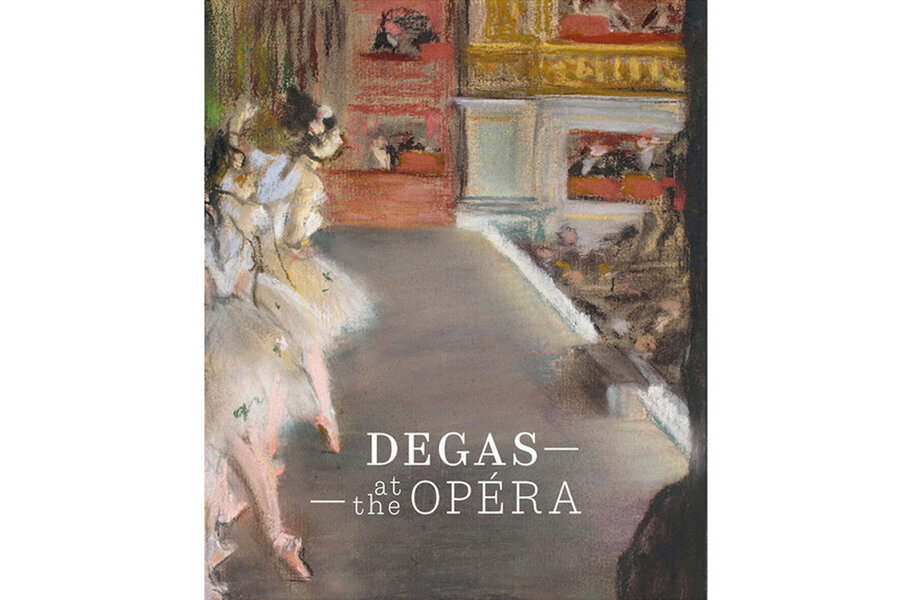Degas painted dancers and musicians with deftness and authority
Loading...
Edgar Degas’ paintings of dancers are among his best-known and most-beloved works. Ballerinas stretching at the barre, lacing their toe shoes, and lounging in the wings are captured on canvas or in pastel.
A major show featuring his work was scheduled to open this spring at the National Gallery of Art in Washington. However, with museums closed because of the coronavirus outbreak, art lovers will need to satisfy themselves with lavish books such as “Degas at the Opéra,” by Henri Loyrette. It features beautifully reproduced images from the exhibition of the same title, which originated at the Musée d’Orsay in Paris.
The Paris Opéra was founded by King Louis XIV in 1669 and the Opéra Ballet is the oldest national ballet company in the world. The music and pageantry attracted Degas; between 1885 and 1892 he attended the opera 177 times, with 55 visits in 1885 alone. Almost half his work from the mid-1860s to post-1900 was inspired by ballet. He portrayed scenes both on and offstage, from the orchestra pit to the audience boxes, wings, and rehearsal studios. He painted musicians, singers, and theatergoers, but dancers in the corps de ballet became his specialty.
“Degas at the Opéra” conveys the essentials of what made Degas renowned as a “painter of dancers.” For readers who want to go deeper, essays by curators and scholars round out the picture of Degas and his passion.
His exploration of opera motifs was both wide and deep. He returned to similar themes, using a variety of media, including oil, pastel, and charcoal, to create paintings and drawings. Despite his range of subjects, Degas was drawn to the dancers. One wonders if he saw their discipline as parallel to his own, requiring constant practice and mastery before making a creative jeté into individual expression.
Theatrical lighting influenced Degas’ painting. Gas lamps and electric illumination created a fantasy world (called “music-paintings” by the composer Richard Wagner), in which elaborate sets seemed to spring to life. Degas relished the effect of the footlights on performers’ faces, which rendered them distorted and mask-like. Such an unusual approach caused his work to be deemed modern, an example of a movement that he called the New Painting.
Degas is thought of as an Impressionist, a designation he detested, although he founded the movement and organized and participated in Impressionist exhibitions from 1874 to 1886. But he never shared Édouard Monet’s or Pierre-Auguste Renoir’s love of plein-air painting or their zeal to capture the transient effects of daylight and atmosphere. He preferred to work in his studio, basing his work on countless sketches. Although subjects drawn from the opera dominated the work he exhibited, his goal was never to document life but to transform it. As Degas wrote, “one sees as one wants to see; this is false; and this falseness constitutes art.”
Art for Degas was not a pretty face or elegant stage set. His dancers are hardly ethereal but reflect the quintessential French concept of jolie-laide (pretty-ugly). His dancers are often caught in awkward, ungainly poses, stretching and yawning, or slumped, exhausted. Degas’ nonidealized view of the opera is characterized by unconventional twists like decentered compositions, plunging diagonals, and cutoff figures. His asymmetrical framing evokes the unstable world of the time.
The lives of dancers were not easy or comfortable, and they were vulnerable to sexual exploitation. As ballet students, they were nicknamed petits rats for their scurrying footsteps. Many of them came from poor families, and they often had no alternative but to accept the lecherous attentions of their wealthy male admirers. In this respect, Degas’ paintings of backstage life reflect an observation of reality. Although his dancers’ bodies are not eroticized, he shows predatory, top-hatted subscribers circling the young girls to evaluate them as potential conquests, as in “Dancers Backstage” (1876-83). Degas pulls aside the curtain on a sordid truth of that dazzling world.
Degas himself did not have the money to be an opera subscriber; he relied on acquaintances to obtain backstage passes. While not much is known about Degas in this respect, he apparently did not have sexual relationships with his models, unlike many other male artists of his day.
By the 1890s, Degas’ eyesight was deteriorating, which precipitated a more radical approach to his art. He retained the world of opera as his subject, yet he used charcoal and pastel to portray dancers in boldly outlined, flat planes. He simplified the forms he knew so well from years of study, portraying performers’ poses with fluid lines and strident, lurid hues as in his acid-yellow “Harlequin” (1884). Degas called them “orgies of color.”
Degas never stopped experimenting, moving from one medium or technique to another, constantly evolving. At age 60 he proudly proclaimed, “Never have I been so young as today.” As his sight waned, his vision was fed by memory and imagination, resulting in daring works with (as he said of his preferred model) “that touch of ugliness without which, no salvation.”
Carol Strickland is author of “The Annotated Mona Lisa: A Crash Course in Art History from Prehistoric to the Present” and an introduction to the history of architecture, “The Annotated Arch.” Her interactive e-book, “Impressionism: A Legacy of Light,” is available from Erudition Digital.






